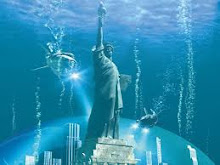
The ancient ritual of the Golden Man -- "El Dorado" in Spanish -- disappeared long before the arrival of the Spanish in South America, but the legend lured droves of conquistadors and looters to this small lake in the Colombian Andes. A gold-covered man, they reasoned, must be from a city of gold.
Although the golden city was never found, the search for El Dorado and its fabulous variants continued across the New World as it was being explored, feeding the greed and the imagination of the invaders. Most returned poor and decimated by disease but the name of El Dorado became linked to wealth and plenty.
Several South American countries claim the legend as their own, but for many historians and researchers, Lake Guatavita, two hours' drive north of the Colombian capital of Bogota, remains one of the most credible sources of El Dorado.
Since the arrival of the Spanish here in 1536, a tenth of a ton of gold artifacts has been fished from its muddy bottom by brash treasure-hunters and explorers, and in 1968 a solid gold miniature was discovered in a cave that depicts the Golden Man and his shamans aboard their raft, midway into their ritual.
"Gold was a sacred metal for the Indians. It was a symbol of fertility and life. For the Europeans, on the other hand, it was money and riches," said Eduardo Londono, an anthropologist at the Gold Museum in Bogota.
The lake stands peaceful now, disturbed only by the wind that sends ripples across its blue-green surface. Not even a tourist can be seen. Earlier this year, the government closed the site because people were washing cars in the lake -- and throwing garbage instead of gold. A lonely ranger with a shotgun is the only guardian of the mystery of El Dorado.
A NEW WORLD MYTH
Christopher Columbus was the first European to record tales about splendid lands of gold upon arriving in the Antilles.
Aware of the fascination gold exerted on the Spanish, the natives began spinning stories of faraway "mountains and ranges of gold" to drive the conquerors from the villages, wrote Spanish priest and Indian advocate Bartolome de Las Casas in his "History of the Indies" in the XVI century.
As new regions were explored, the imagined location of the Golden Man and his fantastic country shifted. El Dorado was always across the next ridge or deeper in the jungle, and descriptions of it became more and more elaborate -- even the trees were said to be made of gold.
The legend of El Dorado, along with other images of the New World, was written down, creating the first texts of a Latin American literature universally known for its magical nature.
Adventurers searched in vain for El Dorado in Colombia, Ecuador, Peru, Mexico and Venezuela and along the Amazon and Orinoco rivers. These countries today lay claim to El Dorado.
"The South American countries fight among themselves for the ownership of El Dorado. It's something that forms part of the identity of the countries of South America," Londono said.
No European saw the Golden Man's ceremony that the Muisca Indians performed at Guatavita, but in 1636 Spanish chronicler Juan Rodriguez Freyle described it based on accounts gathered from later generations of Indians. The gold raft, believed to date from 1400 AD, is now proudly displayed at the Gold Museum.
The serenity of the lake makes it hard to imagine the turmoil that surrounded it for centuries, as waves of explorers and scavengers attempted to relieve the lake of its treasure.
SPANISH DRAINED LAKE WITH GOURD BUCKETS
In 1545, conquistador Hernan Perez de Quesada used slave laborers to scoop water out with gourd buckets. After three months, the chain lowered the water level by 10 feet and Quesada plucked 40 pounds (18 kg) of gold from the shores.
Forty years later, a rich Spanish merchant hacked a crude notch in the lake's rim. The water was lowered by 66 feet, but the cut collapsed, killing hundreds of Indian workmen. No records exist detailing the merchant's findings.
In 1911, an English gold company succeeded in emptying the lake with an ingenious system of sluices and tunnels, but, as if cursed by the Golden Man, the muddy bottom hardened quickly to an impenetrable cement and rain soon refilled the lake. The company was forced to auction the few gold objects it found at Sotheby's in London to pay off its many debtors.
Other explorers who searched for El Dorado included the Elizabethan poet and adventurer Sir Walter Raleigh, who in 1595 sailed 400 miles down the Orinoco. The Englishman braved hunger, sickness and Indians with poisoned arrows but returned empty-handed. Nevertheless, Raleigh wrote in his "Discovery of Guiana" that somewhere in the jungle must exist "more rich and beautiful cities than either Cortes found in Mexico or Pizarro in Peru."
Carl Langebaek, an archeologist at Bogota's Los Andes University, said El Dorado was a product of the explorers' overwrought imaginations, conceived during gruesome journeys in which they sometimes ate their horses and dogs to survive.
"El Dorado will never be found. People will always be looking for gold in the most improbable places. It doesn't matter if they find a castle of gold, there will always be another El Dorado waiting to be found," Langebaek said.
Jaime Beltran, the ranger posted at Lake Guatavita, says he is convinced the lake holds the secret to El Dorado. The jovial and chatty ranger says he whiles away the long hours sitting on a rock overlooking the water and imaging his gold-covered ancestor heaping treasures into the lake.
"I'm sure there is gold from El Dorado down there," he said, looking into the still, dark waters. "But a lot of it has already been taken away."

0 comments:
Post a Comment